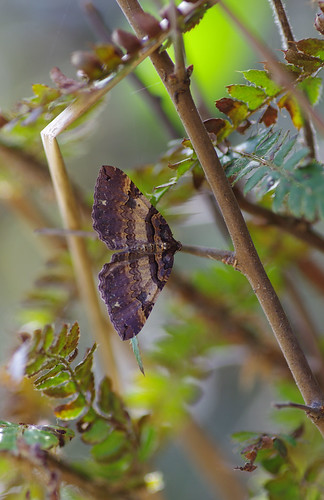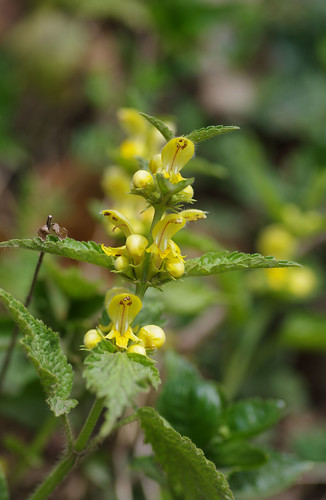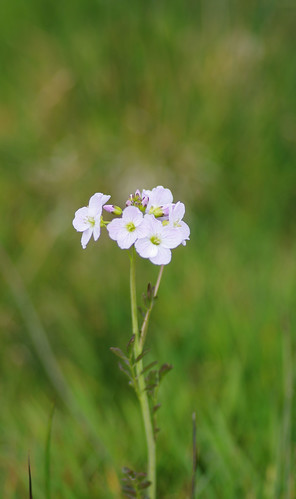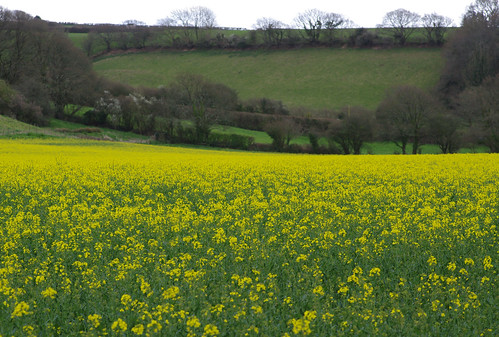The lanes around Loddiswell
Going the extra mile to find new species can have its drawbacks. It's a glorious Sunday morning in the middle of nowhere but the road we're on has become a rat-run. There's nothing much of interest in the hedges, either. Everything is faded and wilting and sprinkled with dust. My low stocks of patience are running out and not about to be replenished. Several times, I increase the pace to a purposeful march but invariably have to slow down and pull in to the side for passing traffic. A wave of acknowledgement would be nice. Just as many motorists feel the road belongs to them alone, so walkers can grow weary of and hostile to endless streams of cars disrupting their rhythm.
There is more to be seen when you're not just passing through a landscape. On two feet, the journey is continually enlightened, or so the theory goes. On the folded-up OS map, this stretch seems easily negotiable. On the ground, the piece of string seems to have stretched indefinitely. We're not at one with the elements here. In fact it seems the elements are conspiring against us. Every whiff of breeze has been sucked from between this lane, to the extent that the cars whizzing perilously close to us and the hedge, almost offer a breath of relief.
Finally, avenues of trees and then another stretch. Cow parsley lines the lane but with the camera poised suddenly nothing stops still long enough. Where did that wind come from? I had a feeling it was going to be one of those days...
Let's rewind to the start of our walk, slap bang in the village of Loddiswell, where a bank of multi-coloured, shiny-faced primroses gave us cause to smile. A wasp that might have been a hornet flew over our heads and on to the mast of a telegraph pole. We followed a path between houses and then turned right along Clarks Barn Road. Bright sunlight and a brisk breeze - a difficult combination for photographing caterpillars at the best of times. I used my body as a shade but the results were still less than ideal. Sherry left the Drinker moth caterpillar to its morning munch and we went on our way seeing what other subjects might populate the margins on both sides.

Greater Stitchworts (Stellaria holostea)
These flowers are common around Devon but in bright light the camera has struggled in the past to depict what we've seen. The flowers above look clear enough but I think the results could be improved if the white balance was given a tweak or two.
We continued down the lane to a stream, a bridge and a junction of paths. The bridleway we selected was gravelly and uninspiring at first but as we ascended the hill we warmed to its charms.

There were celandines and wild garlic leaves and flowers, violets and primroses. At the top, the path transformed into a dirt track. A bee fly flew frantically around. Was it looking for a suitable site to deposit eggs? We struggled to keep up with its movements and turned towards Loddiswell along the never-ending road.
Later, we passed the blurry, waving stands of cow parsley and left the road behind at Green Bank Farm. The track led down to give us a view of Loddiswell's church, perched high up on the hill. We scanned the hedges and after lunch on the edge of a field carpeted with speedwells, inadvertently disturbed a moth.

Shoulder Stripe Moth (Anticlea badiata)
Shoulder Stripes are a common species of the Carpet family we have not encountered before. We spent a few minutes cautiously tiptoeing towards this moth as it chose different hiding places but finally allowed Sherry a shot. The patterns are like carpets although they can be hard to tell apart. Luckily for me, this was one of the easier species to distinguish.
Past the end of the wonderfully-titled Hoppy Green Lane, we went along a low-lying country road we had passed once before. Past Knap Mill, the area is liable to flooding but because of the protracted dry spell the puddles on the road were conspicuous by their absence.

Yellow Archangel (Lamiastrum galeobdolon)
There were several Yellow Archangels to choose from but this leaning specimen caught Sherry's eye. Running sleepily by the side of the lane, we came to the River Avon. The Lady loves nothing better than to soothe hot pads and did not stand on ceremony. (I often wonder how well I would fare without the protection of boots and socks. I suspect the answer might be pretty hopeless.)

Shakin' all over
The Lady enjoyed her dip very much and was reluctant to leave the river behind. Gradually, the lane parted company with the Avon and we returned to the matter in hand; namely finding more flowers. The breeze had eased by this juncture and the light was less harsh.

Bush Vetch (Vicia sepium)
Another common species along lanes and in hedgerows in this part of the world, though no less welcome a sight for all that.

Primroses (Primula vulgaris)
As are these magnificent bunch of primroses. With their pale, delicate colours they are one of the most joyous and liberating indicators that spring has sprung.

Marsh-marigolds (Caltha palustris)
There were so many large groups of these flowers in a pond just away from the road that Sherry was spoilt for choice. Then we left the lane over a stile. Our path intersected a normally-damp meadow (at least it was marshy the last time we came through).

Pink form of Spanish Bluebell (Hyacinthoides hispanica)
This solitary bluebell really stood out among the lush grasses. Spanish bluebells are colonising new areas and (it is often argued) threatening native bluebells in the process. I often expect to see great swathes of them so it felt strange to see this pink beauty growing alone with no neighbours in sight.


A Cuckooflower on its own (top) and as a group (above)
Notice the range in colour; proof that flowers cannot be identified on the strengths of colour alone. Both photographs were taken in the same meadow.

Cultivated field of Rape (Brassica napus)
We had reached the outskirts of Loddiswell and faced a final climb up the hill and a short section of busy, narrow road. One final photo opportunity proved too good to pass up.

Flower spike of the Cherry Laurel Tree (Prunus laurocerasus)
We took one last detour, along a path leading to the village church. Bees were gathering around a marshy stream for a drink. We timed our jump and walked on to the source of the village name. Loddiswell has Saxon origins, meaning Lod's well. Lod must have been a wealthy landowner and would probably have appreciated his name living on for posterity.
Sherry and I have been to Loddiswell several times before. Usually, we have a hot chocolate in the Garden Centre coffee shop and then head off along the Primrose Line (a disused railway that is now a nature reserve.) I'm glad we decided to explore somewhere different. There are many sides to each and every place and I'm sure we haven't seen every aspect of Loddiswell yet.

Comments
Add a Comment